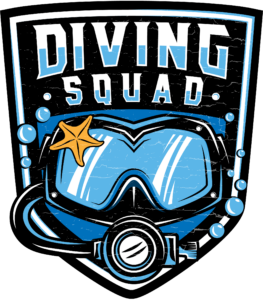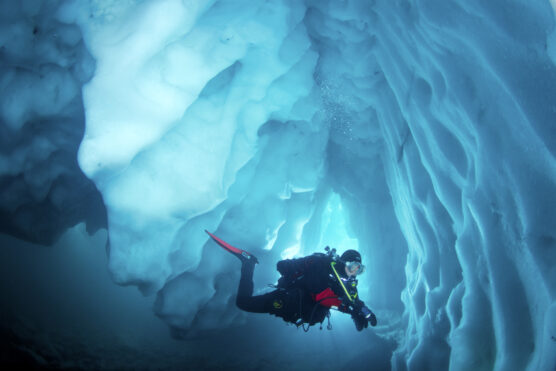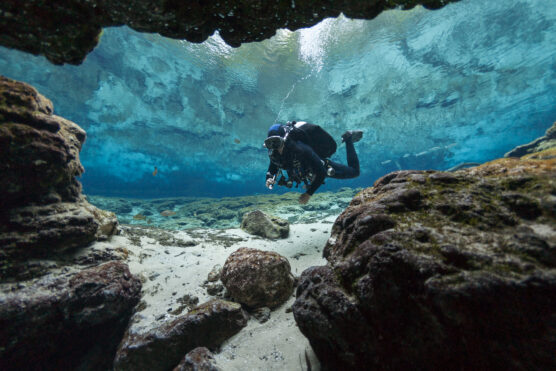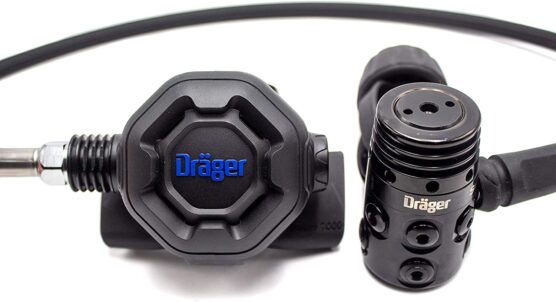
Best Cold Water Regulators of 2024
(This is a sub-article from our main page on scuba diving regulators).
Although the majority of recreational scuba diving takes place in warm water, a few fanatics and some folks living in icy regions prefer to dive cold!
Needless to say, in cold water conditions, you’ll need much warmer gear but you’ll also need a regulator that is specially designed for cold water, so that it does not malfunction.
Enter cold water regulators, which implement special features and designs to ensure they do not freeze or free-flow (we’ll explain more on this in a bit).
In this guide, we’ve brutally reviewed our favourite 6 top cold water regulator available this year. Dive down to the Quick Look for a rapid-fire answer or descend deeper to our Reviews for more in-depth info!
Next, we explain the designs and features of cold waters that set them apart from regular, warm water regulators. Let’s do this!
QUICK LOOK
Our Top Pick: Cressi MC9 XS Balanced Dive Regulator
Most Affordable Cold Water Regulator: Palantic AS101 Din Dive Regulator
Excellent Value Cold Water Regulator: Drager Secor 7000 Black
Hyper-Balanced Regulator: Cressi Master T10 DIN Regulator
Most Comfortable Cold Water Regulator: Aqua Lung Core Regulator
Best Piston Cold Water Regulator: Scubapro MK25 EVO
REVIEWS of Best Cold Water Regulators
1) TOP PICK: Cressi MC9 XS Compact
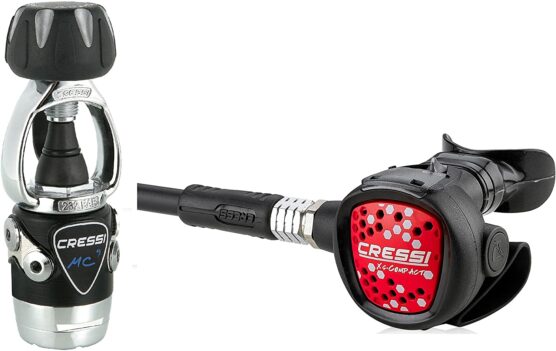
The Cressi MC9 XS Compact is our number one pick as the best cold water regulator available this year.
It is extremely well priced and offers crucial features for extremely cold temperatures as low as 39.4 degrees Fahrenheit; namely its environmental seal and hyper-balanced diaphragm.
The environmental seal prevents cold water from making its way into the first stage, ensuring you don’t get any free flows. It also helps prevent salt and other particles from entering your device, resulting in a longer product life span.
Meanwhile, the hyper-balanced diaphragm ensures you can breathe easily regardless of the external conditions – like diving at lower depths or when your tank starts running low.
When you’re trying to set up your regulator, you’ll notice that it has two opposing high-pressure ports. This is a great addition as it allows you to position the first stage either up or down and you can add an extra SPG or dive computer on those cold deep-sea dives.
Cressi has also thrown in a dive & pre-dive venturi switch into this product. This enables or disables the venturi effect, which reduces the effort required to open the diaphragm to breathe. While diving, you can benefit from an easier breath, but on the surface, you can disable the feature to prevent unnecessary free flows.
This regulator’s second stage has been made from lightweight technology to provide all the benefits of a cold water regulator with much less hassle. This part only weighs only 135g, while the other second stages on this list range from 200g and up.
The regulator was kept lightweight by combining a stainless steel first stage with a techno-polymer second stage, producing a product that can withstand cold conditions whilst remaining travel-friendly.
PROS:
- Environmentally sealed
- Lightweight cold water regulator
- 2 high-pressure hose connections
- DIN or Yoke versions available
- Venturi switch
CONS:
- Regulator hose fairly short
- Lightweight design reduces heat sink size
2) Cheapest Cold Water Regulator: Palantic AS101
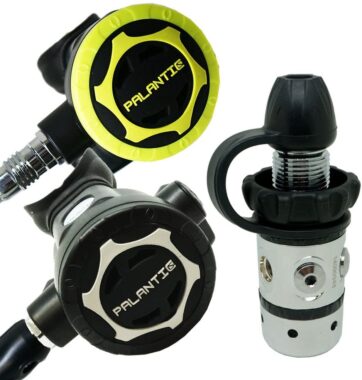
Diving regulators, especially those used in cold waters, can be pretty expensive. If you’re trying to find a low-temperature regulator that isn’t going to break the bank, the AS101 is the cheapest option going.
This DIN valve cold water regulator is environmentally sealed to ensure that no water or contaminants enter into your first stage. This is an excellent feature to prevent freezing and free flow accidents while diving in very cold waters.
The second stage might not be adjustable, but the breathability is very smooth and provides great flow even in very low depths. This is thanks to the simple single-piston shaft design that reduces the chances of malfunctions.
The oxygen supply is also balanced, which helps provide a consistent breath even when you are running low on oxygen towards the end of a long dive.
The Palantic AS101 dive regulator uses a DIN valve – there is no yoke version available. This means you would be smart to pick up a DIN to Yoke adapter to make your life a little bit easier if you plan on diving in America. After all, most USA dive shops don’t stock DIN valve tanks.
Don’t let the low price tag fool you. This cold water regulator can stand up against even the priciest of regulators, although it might not have all the bells and whistles we have come to expect – like adjustable flow rate and diaphragm breathing. But it still get’s the job done!
PROS:
Cheapest cold water regulator available
Simple, yet quality piston regulator
Overbalanced oxygen supply
First-stage has a full metal heat sink
CONS:
Non-adjustable second stage
Only comes with DIN valve
- Cheap hose may need replacement
3) Excellent Value: Drager Secor 7000
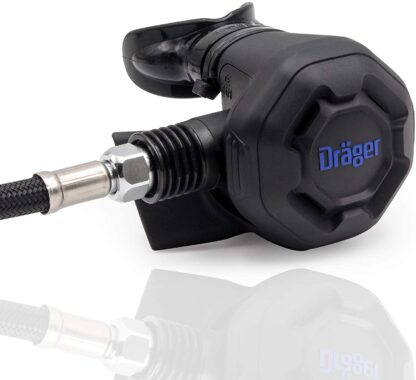
This mid-priced diving regulator can live up to both cold and warm conditions thanks to its high-quality materials and diaphragm membrane. It is not environmentally sealed, but still is a reliable choice for temperatures as low as 35.4 degrees Fahrenheit.
At first glance, you might think that the Drager Secor is made of plastic – which is not ideal for cold water performance. However, although it appears black, that is just the Teflon coating used to protect the metal.
This still ensures that there is optimal heat transfer between the first stage and the surrounding water, helping to prevent freezing and free flows. However, the metal will also last much longer while not being directly exposed to saltwater and other contaminants while diving.
The second stage mouthpiece is made of silicon, which makes it very comfortable, lightweight, and easy to clean/disinfect if you are sharing a device.
Another benefit of Drager’s design is that you can open the mouthpiece without any tools. This allows for easy cleaning after every dive, helping improve the lifespan of this diving regulator.
One of the most important things about a diving regulator is how it breathes. This is one of the balanced regulators that helps to ensure that divers always get a uniform breathing experience. Drager has used a diaphragm instead of a piston for breathing. This means less oxygen will be released than with a piston-based regulator, which reduces the chances of freezing or free flows occurring.
The Drager Secor 7000 is an affordable regulator that offers everything you need for cold water diving. The combination of metal for heat transferal and a diaphragm membrane for reduced free flows makes this a suitable option for almost any environment.
PROS:
- Teflon coated metal regulator
- Diaphragm design for cold water
- Easy-to-open mouthpiece for cleaning
- Host connection on either side of second-stage
CONS:
- Not environmentally sealed
4) Hyper-Balanced: Cressi Master T10 Din Regulator
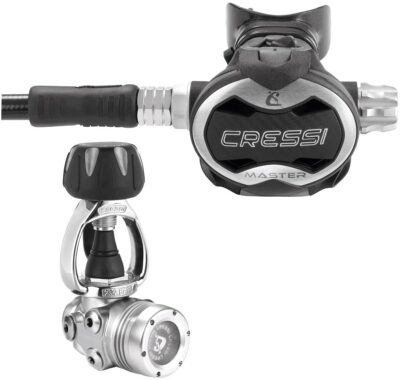
This another excellent cold water diving regulator by Cressi. This one might not be environmentally sealed but still comes with a high-quality DIN valve and metal casing to ensure optimal safety when diving in extreme cold conditions (tested at 36.4 degrees Fahrenheit). There is a yoke valve version if you plan on doing a lot of diving in the USA.
Metal is used throughout the regulator, from the first stage to the metal second stage fittings. It is all chrome coated and features a brass alloy body, which has excellent thermal conductivity. You can even see a stylish metal heat sink at the back of your mouthpiece.
The regulator is air-balanced, which will help divers enjoy a consistent breathing experience no matter how deep they go – this is especially important if you plan on doing some cold underwater cave exploring.
If you aren’t happy with the amount of oxygen you are getting, you can simply use the chrome-coated brass adjustable flow rate knob to dial it in.
If you are a cold-water diver, this feature will allow you to reduce the amount of oxygen you receive – which further helps prevent a regulator freeze. However, this is a diaphragm regulator, so it already provides less oxygen than a piston regulator which helps reduce free flows in colder water.
There are two high-pressure ports that help with attaching additional equipment as well as allowing up or down scuba regulator orientation.
This is a diaphragm regulator that can stand up to cold water diving environments thanks to its heat transferability, adjustable flow rate, and air-balanced breathing.
PROS:
- Two high-pressure & four low-pressure ports
- Brass metal body for heat dispersal
- Heat exchanger on second-stage
- Easy-to-use adjustable flow rate valve
- DIN and Yoke versions
- Balanced regulator
CONS:
- No environmental seal
5) Most Comfortable: Aqua Lung Core
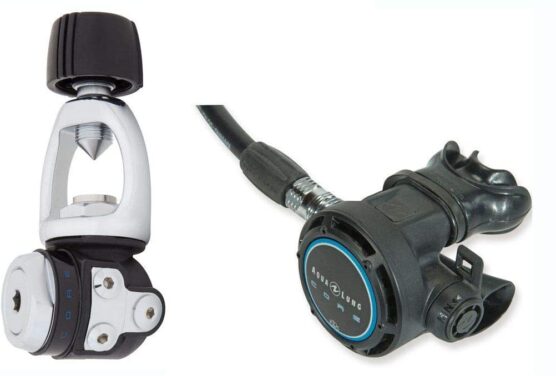
Reasonably priced, high quality and extremely comfortable, the Aqua Lung Core is a great alternative choice for cold water divers.
Aqua Lung have included their ‘Auto Closure Device’ which is an environmental seal that prevents water from entering the first stage of the scuba regulator – perfect for low temperatures below 50 degrees Fahrenheit.
You can attach the regulator to your device with either a yoke or din valve (depending on which version you choose). The DIN valve is, however, more recommended for cold conditions and can withstand up to 300 bar (compared to 232 on a yoke valve).
Note: You can easily convert the bar to PSI. Depending on where you’re scuba diving, they may use different units of measurement.
The breathing is controlled by the balanced diaphragm which helps prevent free flows in cold waters but also maintains a consistent level of oxygen throughout your dive. This device has really easy breathing and received a ‘superior’ rating on the ANSTI breathing machine.
These features mean you should have no problem getting enough oxygen at any level of your dive. Throw in the patented Comfo-bite mouthpiece (preventing jaw fatigue) and the easy-to-grip venturi switch that prevents and you will have a very smooth diving experience.
The Aqua Lung Core Regulator is a great choice for longer dives due to its comfortable mouthpiece and venturi-assisted balanced breathing. It is a well-rounded mid-range regulator that can handle colder diving conditions and still provide a smooth breath.
PROS:
- Environmentally sealed
- Venturi switch
- Diaphragm breathing
- Easy breathing
- Superior ANSTI rating
- Comfo-bite mouthpiece reduces jaw fatigue
CONS:
- First-stage doesn’t have a full metal body
6) Best Piston Cold Water Regulator: Scubapro MK25 EVO
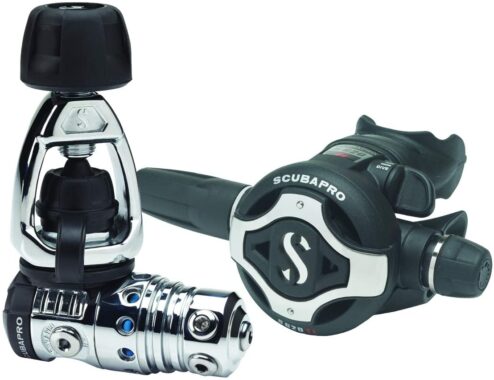
Although diaphragm regulators are considered to be the best for cold water diving, some divers do not enjoy the increased breathing resistance it provides. The Scubapro MK25 Evo is a cold water regulator that offers piston breathing, allowing for a larger breathe every time you pull.
This cold water regulator does not come environmentally sealed, but it makes up for this with a full chrome plated brass body, which acts as a very effective heat sink.
Scuba pro has also used their patented exits to help create a thermally insulated first and second stage. The result? A regulator that is can withstand cold conditions without the need for an environmental seal.
The above-mentioned anti-freezing properties also tie in well with the piston design to create an easy breathing regulator that can reach temperatures of 36 degrees Fahrenheit.
The Scubapro MK25 Evo uses a Yoke valve, which is perfect for use in the USA as most shops only offer these types of tanks anyway.
There are two opposing high-pressure ports available on this regulator, allowing you to position your regulator up/down or add an extra piece of HP equipment.
For those who can afford it and for whom easy breathing is a priority, the Scubapro MK25 Evo is the best cold water regulator on the market.
PROS:
- Balanced dive regulator
- Best piston regulator
- Lightweight second-stage
- Venturi switch
- Adjustable flow rate
CONS:
- No environmental seal
- Quite pricey
What makes a Scuba Regulator suitable for Cold Water?
Now that you’ve seen some of the best regulators for cold waters on the market, you might be wondering “What’s the difference between a cold water and a warm water regulator”?
Even though all regulators do the same thing – safely change high-pressure compressed air supply to ambient pressure for human consumption – not all of them work the same in cold waters.
In this section, we’re going to look at the differences between these two types of regulators so that you know exactly why you should spend a little bit extra.
Although many standard regulators can do the job in relatively cold waters, if you’re planning on scuba diving in the extreme cold then you need to consider safety as your number one priority.
Cold Water Regulator Characteristics:
Temperature
The most obvious difference between the best regulator for cold and warm water diving is the water temperature that they can withstand. Even though all regulators can handle warm waters, only the best cold water regulators should be used in waters below 60 degrees Fahrenheit.
This is due to the two biggest risks when scuba diving in extremely cold temperatures – freezing and free flow. “But how can oxygen freeze?”. Well considering the freezing point of oxygen is approximately -362 degrees Fahrenheit and the coldest oceans in the world only get to 28 degrees Fahrenheit, you’re definitely asking the right question.
It isn’t the oxygen that is at risk of freezing, but the regulator parts themselves. Although that might not seem like much of a problem, it is when it leads to a free flow. A ‘free flow’ is when your second stage regulator no longer ‘closes’ (prevents oxygen from escaping) and, as the name suggests, the oxygen starts flowing freely out of your mouthpiece.
Can you imagine being 30 minutes into a dive when all of a sudden your regulator starts spitting out your precious oxygen? “Bubbles! My Bubbles.”. Although Dory thought they were cute in Finding Nemo, it’s not so cute when you don’t have gills. And that’s why you need a cold water regulator when diving in cold water!
Note: In severe cases of freezing, your oxygen supply could be cut off entirely, forcing you to use your emergency octopus.
Weight / Material
One of the biggest things you’ll notice when comparing a cold water and warm water regulator is the weight. This is to do with the materials used when making the products. Warm water regulators are lighter and are usually made with cheaper plastic materials.
These are much easier to travel with and are a great (and affordable) way to travel around the world with your own regulator. (Read more about the best travel regulators!).
Of course, the lighter warm water regulators are more convenient, so then why are the best cold water regulators so much heavier? Well, it has to do with the two things I keep mentioning – freezing and free flow.
As I’ve mentioned, when high-pressure gas is released your regulator gets very cold and is at risk of freezing. To prevent this, metal is used because it is a better heat conductor. “But what heat is there in cold water?”. Although it might seem surprising, the ‘cold water’ that you are scuba diving in is still warmer than the temperature drop due to the change in pressure.
For this reason, metal second stage and first stage scuba regulators are the golden standard for cold water dives. It improves the surface area to volume ratio, which allows more of the cold to be absorbed by the surrounding water. The metal regulators act as a ‘heat sink’ or ‘heat exchanger’ – terms you will see being thrown around a lot.
Although you might not enjoy the extra carrying weight, this difference is one of the main characteristics of a cold water regulator and a must-have in extreme temperatures.
Features of a Cold Water Regulator
The best cold water regulators are made using top-quality materials and are guaranteed to withstand cold temperatures. Although there are plenty of different types available, some are made better than others.
If you’re looking for a cold water regulator, there are a few features that you may have come across. Although some of these features are based on preference, it’s always best to consider what is available so that you can make the best choice.
Cold Water Regulator Features:
Din vs Yoke Valve
If you’ve been diving in the USA, you most probably have come across a yoke mechanical valve before. For a long time, these were the standard when it came to first-stage regulator fittings. However, they are not the best when it comes to cold water diving, technical diving, or cave dives.
Although this has less to do with cold water and more to do with overall safety. DIN valves are threaded valves that screw directly into your scuba tank and, therefore, create a much tighter seal compared to the A-clamps used on yoke valves.
The main difference is the pressure it can handle. DIN fittings can exceed 232 bar, while that is not recommended for yoke scuba regulators. If you’re going to be doing a lot of cold water or technical diving, this is a feature that is recommended.
Environmentally Sealed
When searching for cold water regulators, you will come across some that are environmentally sealed and others that are not. An environmental seal is an added silicon fluid barrier that prevents residue and cold water from entering the first stage. The reason for this is the same as we mentioned above – to prevent freezing and free flows.
When high-pressure gas is released from a container, it comes out extremely cold. Combine this with very cold water and you have a big risk of freezing which can cause free flows. Depending on how cold you plan on going, a seal is definitely a feature to consider. However, if you only plan on doing moderately cold dives, then you should be able to make do without it.
Balance vs Unbalanced
Unbalanced regulators are significantly cheaper, but will reduce the amount of oxygen you get when running low. This can be worrying for amateur divers, which can lead to increased heart rate, breathing, and panic – three things you don’t want when diving in cold waters.
Balanced regulators will deliver the same amount of oxygen throughout your dive – ensuring that it is comfortable and easy to breathe.
Piston vs Diaphragm Regulator
When diving in cold waters, you want to consider whether your regulator uses a piston or diaphragm to deliver oxygen. Piston regulators are easier to breathe and will deliver a higher rate of oxygen than a diaphragm.
However, in cold water diving, smaller breaths are better as it reduces the risk of freezing / free flows. The less gas that leaves the tank in one go, the better. If you’re tackling extremely cold water, this is a feature that we recommend.
Adjustable Flow Rates
When it comes to cold water diving and oxygen – less is more. Three features can change the ease of breathing, namely an inhalation adjustment knob, a venturi control, and a pre-dive switch.
The inhalation adjustment knob simply changes breathing resistance (increasing or decreasing how much oxygen you get). This is an especially important feature in cold water regulators. The less oxygen flowing through the first stage, the less chance of freezing or free flow.
Venturi switches are a unique feature that makes it easier to breathe when using a diaphragm regulator (another pro feature for cold water diving) and helps prevent free flows. A pre-dive switch reduces regulator flow when starting your dive, which helps prevent unnecessary free flows on the surface.
Diving Squad Debriefing
Diving Squad – at ease! You’ve just finished this whale shark of an article, explaining everything you need to know about the specs, uses and features of cold water regulators with 6 brutally honest reviews of our top picks for this year.
We’re constantly scouring the seven seas for new products and information so you can rest assured that everything you’ve read today reflects the very latest information on cold water regulators.
Don’t forget that for most scuba diving, you won’t actually need a cold water regulator. A warm water regulator will serve you just fine.
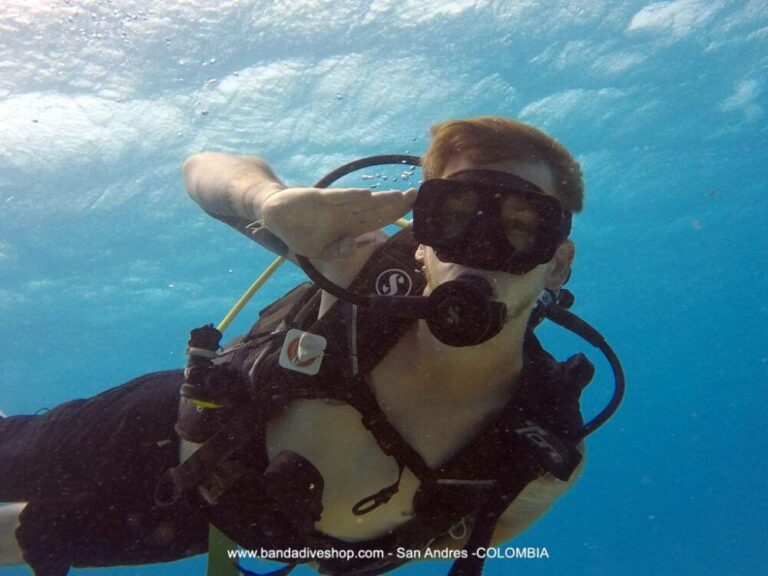
Support the Squad!
We are part of the Amazon Services LLC Associate Program. If you make a purchase on amazon after clicking a link on Diving Squad, we earn a small commission fee, at no extra cost to yourself.
We are also part of several other affiliate programs so if you click on a Diving Squad affiliate link that results in you booking a liveaboard, booking accommodation, purchasing insurance or buying a product somewhere else, once more we make a small commission, without it costing you a cent extra. Thanks!
Written by:
Jo Richards
